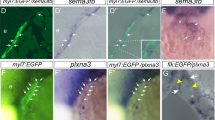Abstract
The two cardiac progenitor cell lineages, cardiac neural crest cells (cNCCs) and the second heart field (SHF), play key roles in the development of the cardiac outflow tract (OFT). Both cardiac progenitor cells interact with each other and contribute to OFT formation cooperatively. The neurovascular guiding molecule, semaphorin 3c (Sema3c), is thought to serve as a key attractant for the migration of cNCCs. A previous study reported that Tbx1 null mice showed a significant reduction in Sema3c expression in the OFT region [1]. However, the regulatory effect of Tbx1 on Sema3c was unclear. Here, we show that Sema3c plays key roles in cNCCs-SHF interactions through the regulation by Tbx1 and other molecules during OFT development [2].
You have full access to this open access chapter, Download conference paper PDF
Similar content being viewed by others
Keywords
The two cardiac progenitor cell lineages, cardiac neural crest cells (cNCCs) and the second heart field (SHF), play key roles in the development of the cardiac outflow tract (OFT). Both cardiac progenitor cells interact with each other and contribute to OFT formation cooperatively. The neurovascular guiding molecule, semaphorin 3c (Sema3c), is thought to serve as a key attractant for the migration of cNCCs. A previous study reported that Tbx1 null mice showed a significant reduction in Sema3c expression in the OFT region [1]. However, the regulatory effect of Tbx1 on Sema3c was unclear. Here, we show that Sema3c plays key roles in cNCCs-SHF interactions through the regulation by Tbx1 and other molecules during OFT development [2].
By generating reporter transgenic mice harboring Sema3c enhancer fragments and lacZ transgene, we found that Foxc1/c2 directly regulated Sema3c expression in the OFT via direct binding to the Fox-site on the 5′ flanking sequence of Sema3c where Tbx1 synergistically enhanced the Foxc1/c2 function. In comparison, Tbx1 in the SHF inhibited ectopic Sema3c expression in cNCCs within the pharyngeal arch region via Fgf8-ERK signaling. Consistently, the ectopic expression of Sema3c in the cNCCs of Tbx1 hypomorphic mouse embryos caused abnormal migration and/or aggregation, and the overexpression of Sema3c in cultured cNCCs inhibited their migration, resulting in their aggregation. These results suggest that Tbx1-Fgf8-ERK signaling negatively regulates Sema3c expression in cNCCs for the proper guidance of their migration from the dorsal pharyngeal region to the OFT.
In conclusion, a proper temporo-spatial expression of Sema3c, which is tightly regulated positively by Foxc1/c2 and negatively by the Tbx1-Fgf8 cascade, is essential for the correct navigation of cNCCs towards the OFT (Fig. 58.1). This report is the first evidence of a detailed signal transduction mechanism for the interaction between cNCCs and SHF progenitor cells through Sema3c, providing a new molecular basis for a potential therapeutic strategy for congenital heart diseases involving OFT defects.
This work was supported by MEXT KAKENHI, Grant-in-Aid for Scientific Research (B) and Grant-in-Aid for Young Scientists (B), Keio University Academic Development Funds and Brain/MINDS project from AMED, Japan.
References
Kodo K, Shibata S, Miyagawa-Tomita S, et al. Regulation of Sema3c and the interaction between cardiac neural crest and second heart field during outflow tract development. Sci Rep. 2017;7:6771.
Théveniau-Ruissy M, Dandonneau M, Mesbah K, et al. The del22q11.2 candidate gene Tbx1 controls regional outflow tract identity and coronary artery patterning. Circ Res. 2008;103:142–8.
Author information
Authors and Affiliations
Corresponding author
Editor information
Editors and Affiliations
Rights and permissions
Open Access This chapter is licensed under the terms of the Creative Commons Attribution 4.0 International License (http://creativecommons.org/licenses/by/4.0/), which permits use, sharing, adaptation, distribution and reproduction in any medium or format, as long as you give appropriate credit to the original author(s) and the source, provide a link to the Creative Commons license and indicate if changes were made.
The images or other third party material in this chapter are included in the chapter's Creative Commons license, unless indicated otherwise in a credit line to the material. If material is not included in the chapter's Creative Commons license and your intended use is not permitted by statutory regulation or exceeds the permitted use, you will need to obtain permission directly from the copyright holder.
Copyright information
© 2020 The Author(s)
About this paper
Cite this paper
Kodo, K. et al. (2020). A Temporo-Spatial Regulation of Sema3c Is Essential for Interaction of Progenitor Cells during Cardiac Outflow Tract Development. In: Nakanishi, T., Baldwin, H., Fineman, J., Yamagishi, H. (eds) Molecular Mechanism of Congenital Heart Disease and Pulmonary Hypertension. Springer, Singapore. https://doi.org/10.1007/978-981-15-1185-1_58
Download citation
DOI: https://doi.org/10.1007/978-981-15-1185-1_58
Published:
Publisher Name: Springer, Singapore
Print ISBN: 978-981-15-1184-4
Online ISBN: 978-981-15-1185-1
eBook Packages: MedicineMedicine (R0)





